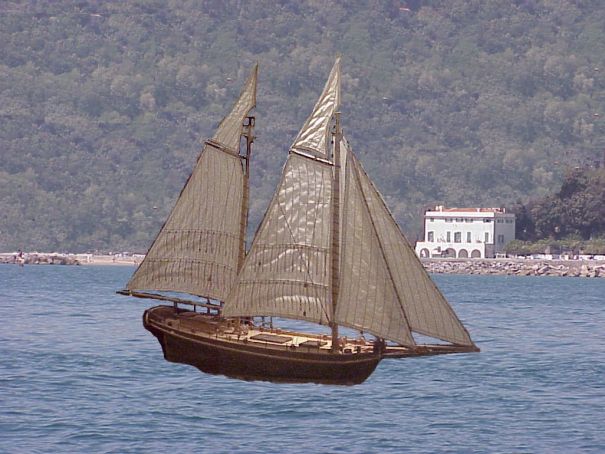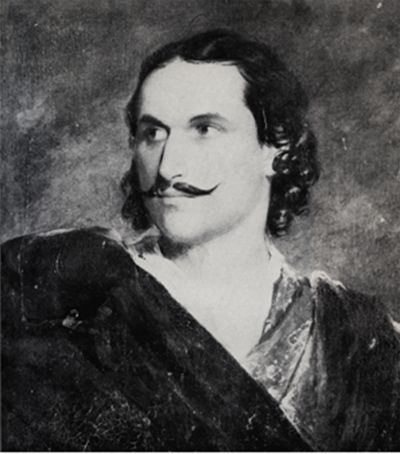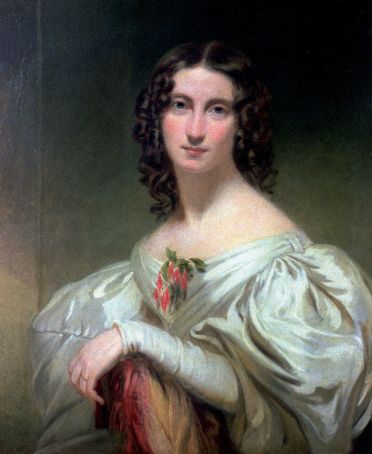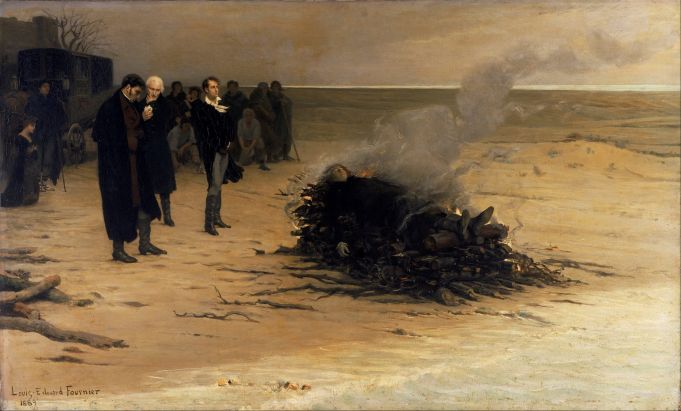Shelley planned to spend the summer of 1822 sailing along the coast of Tuscany but he drowned when his new boat went down in a summer storm.
Percy Bysshe Shelley drowned in a summer storm in the Gulf of Spezia on 8 July 1822. He would have been 30 years old less than a month later, on 4 August. It took 10 days before his almost unrecognisable body was found on the beach just north of Viareggio.
There has been constant speculation in the two centuries since then as to what happened, and his early and tragic end has lent itself to all sorts of romantic and dramatic tales.
Shelley's last journey
On the bicentenary of his death it is generally now accepted that the sinking of his new boat and the drowning of all on board were caused by a summer storm, but the circumstances surrounding Shelley's last journey were complicated and full of enough emotions to have left a trail of stories behind.
The first accounts speculated that he took his own life. Although he was known to be depressed and had recurring bouts of ill health, this narrative seems unlikely considering that there were two other people on board, his good friend and sailing buddy Edward Williams and a young boat hand Charles Vivian. All of them had extensive sailing experience behind them.
Another story that spread was that the boat was attacked by pirates, but there was no evidence of a struggle and all the signs were that the boat sank rapidly and almost without warning.
It is certain from the evidence available that there was a sudden summer storm and such storms along the Mediterranean coast can be very violent. It is also certain that Shelley decided to set sail regardless from Livorno to get back to Lerici, where both the Shelley and Edwards family were living for the summer, rather than wait for better weather.

Mary Shelley had recently had a serious miscarriage, but perhaps even more than that Percy was caught up in one of his endless romantic relationships, this time with Edward's common-law wife, Jane. He may also have wanted to get home quickly because he had been disappointed by the meeting with Lord Byron and Leigh Hunt about the launching of their new magazine, The Liberal.
He was out of sorts with Byron, which was not unusual. Although he had persuaded Byron and his entourage to move to Tuscany from Ravenna for the summer, their friendship was under strain. Byron's rowdy parties and hunting expeditions as well as a rough and bad-tempered run-in with a member of the Pisan garrison all put pressure on the friendship.
Masi affair
The Masi affair, as it was known, started outside the city when a member of the local Pisan garrison tried to ride his way at speed through the Byron entourage strung out across the road. Scuffles and insults flew and eventually Sergeant-Major Masi was wounded by one of Byron's entourage. Relations between the Pisans and the English community were at a low ebb and so were Shelley's relations with Byron.
Shelley's recurring rivalry with Byron resurfaced. As he wrote to Hunt:
"Particular circumstances -- or rather I should say, particular indispositions in Lord B's character render the close and exclusive intimacy with him in which I find myself, intolerable to me; thus much my best friend I will confess and confide to you...However....I will take care to preserve the little influence I may have over this Proteus in whom such strange extremes are reconciled until we meet." Richard Holmes. Shelley. The Pursuit. page 704. Shelley to Hunt, Letters Vol 2.
Lerici
It was in part to get away from Byron that Shelley decided to move to the coast in the spring of 1822. Another reason why the Shelleys and the Williams moved to Lerici was so that Shelley and Edward could sail throughout the summer.
They were sailing buddies and even though Shelley had never been able to swim they both had considerable experience in small boats in lakes and most recently in the inland canals and rivers around Pisa.
For Shelley an additional advantage was that Jane, his latest romantic attachment, would also be there. For Mary, who never liked Casa Magni, the house they had rented on the edge of the sea, it put an additional strain on her uneasy relationship with Shelley, at a time when she was having another difficult pregnancy.

The summer was going to be different from what either Shelley or Williams were used to. Byron who was living in Pisa had recently commissioned a large sea-going yacht, the equivalent of a schooner or a brigantine, to be built in Genoa by Captain Dan Roberts. Shelley, egged on by their mutual friend Edward Trelawny, decided he was not to be outdone and added his own commission, again to be overseen by the flamboyant Trelawny.
These boats were not the usual small skiffs that Shelley loved so much for river sailing, but large sea-going yachts, the super yachts of the early 19th century. Their main characteristic was the two masts and a large area of sail. Byron's yacht was to be called Bolivar, after the South American hero who led most of the continent to independence. Shelley was more romantic. He wanted his yacht to be called Ariel, the character from Shakespeare's play The Tempest. Why Ariel?
Jane Williams
Shakespeare's sprite Ariel was clearly on his mind and The Tempest was one of his favourite Shakespeare works. It was the name with which he identified his relationship with Jane Williams. This could not be more obvious than in the first stanzas of his poem With a Guitar. To Jane
Ariel to Miranda - Take
This slave of music for the sake
Of him who is the slave of thee;
And teach it all the harmony,
In which thou canst, and only thou,
Make the delighted spirit glow,
Till joy denies itself again
And too intense is turned to pain;
For by permission and command
Of thine own prince Ferdinand
Poor Ariel sent this silent token
Of more than ever can be spoken;
Your guardian spirit Ariel, who
From life to life must still pursue
Your happiness, for thus alone
Can Ariel find his own;
So in Shelley's mind the boat had a clear association with Jane. Many still refer to the boat as Ariel. Even a reference to Shelley on the Royal Museums Greenwich website calls it Ariel. Why then did it become known as Don Juan?
Like many of the stories and legends that surround Shelley and Byron the name Don Juan can also be traced back to their friend, adventurer and general mischief maker Trelawny. He was responsible not only for the commissioning of the yachts but he was supposed to have persuaded Shelley to call the boat the Don Juan in honour of Byron's epic satirical poem of the same name, which was causing considerably notoriety at the time and which Byron was still writing in summer 1822.

A somewhat different association could be placed on Trelawny's renaming of Shelley's boat. The connotations of Don Juan and Don Giovanni the fictional womaniser could not have been lost on Shelley and his entourage. Shelley was openly writing about his cooled relationship with Mary at the time. His flirtation with Jane, the wife of his friend Edward, was plain for all to see and his infatuation with Teresa (Emilia) Viviani was the inspiration for his poem Epipsychidion.
No less complicated was Byron's and Percy's relationship with Claire Clairmont, Mary's step-sister. Claire and Byron had an illegitimate daughter, Allegra, who was born in England in early 1817 and who died in April 1822 in the convent where Byron had sent her, much against Claire's wishes. Percy was more often that not the arbiter between Byron on one side and Claire on the other when it came to Allegra and tensions were high in spring 1822 when Allegra died aged five. Claire's open connection with Byron did not help allay suspicions about the relationship between the inseparable Percy and Claire, always the cause of considerable gossip and much of Mary's anguish.
With this in mind the re-naming of Shelley's boat the Don Juan is something more than just a homage to Byron, but also a reference to Percy's way of life as a notorious womaniser. Was this what Trelawny had in mind? No one will ever know. But that Trelawny was a key figure in the lives of the Romantic poets at this time is beyond discussion.

After the discovery of Shelley's body north of Viareggio it was Trelawny who stage-managed the dramatic cremation on the beach. It was Trelawny who was responsible for arranging the internment of Shelley's ashes in the Protestant cemetery in Rome, managing to secure a burial space for himself alongside Shelley at the same time. He may also have been in love with Mary himself and certainly became one of her close entourage after Shelley's death.
Whatever the stories and suspicions that circulated after Shelley's death there were also good technical reasons why the boat went down in the storm. Shelley wanted the area of sail increased to make the yacht faster, so that he could outrace Byron, according to yet another story. But putting on more sail meant that the boat became unstable.
In order to counteract what would have been a potentially dangerous heel when sailing in high winds more ballast was put on board. But as a result the boat sat lower in the water than it should have been in its original design. The danger was obvious enough, but probably no-one expected that Shelley would be out sailing in heavy weather. When the storm hit the boat took on too much water and went under fast.
Of course seafarers and the superstitious will point out that changing the name of a boat is unlucky and should be avoided at all costs. According to this age-old superstition Ariel/Don Juan never stood a chance. And what bitter irony that Shelley took the name Ariel for his boat from one of his favourite Shakespeare works, The Tempest.
By Mary Wilsey
This article was published in the April 2022 edition of Wanted in Rome magazine.
General Info
View on Map
Shelley's Last Summer
55049 Viareggio, Province of Lucca, Italy

















